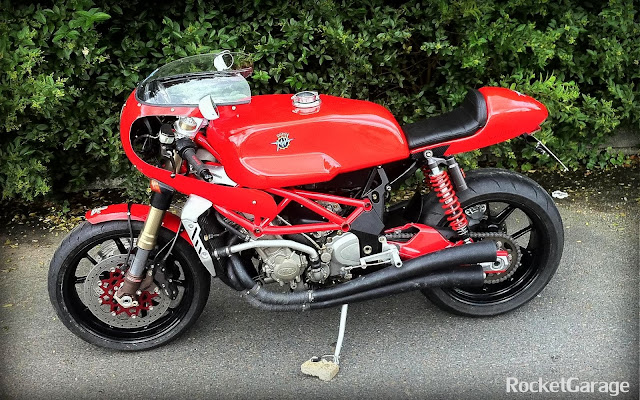MV Agusta 750 Sport
MV's potent four- cylinder engine, with its gear-driven twin overhead cams, owed much to the firm’s all-conquering grand prix race bikes.
This Sport, built as Phil Read was winning MV’s 16th consecutive 500cc world championship in 1973, has the disc front brake introduced that xear.
The 750 Sport with which MV Agusta iH announced its arrival as a manufacturer of Hi roadgoing superbikes was a long time coming, but it proved well worth the wait. The Sport, with its handsome lines, potent 743cc, dohc engine and impressive chassis specification, was stunning: a high performance roadster that was based on the Italian marque’s all-conquering 500cc factory racebikes.
When the Sport reached production in the early 1970s, the small firm from Gallarate, near Milan, was nearing the end of a remarkable era of racetrack domination. MV’s unbroken string of 500cc world titles stretched back to 1958, with riders including John Surtees, Mike Hailwood and Giacomo Agostini. For all this time the firm’s autocratic boss, Count Domenico Agusta, had refused to produce a roadgoing version of the four- cylinder ‘Gallarate fire engines’.
Instead, MV production had concentrated on the small-capacity singles with which Domenico had entered the motorcycle business in 1945, when the Agusta aircraft company was looking for a new direction at the end of the Second World War. Although a stylish 500cc four called the R19 Turismo had generated plenty of interest when displayed at the Milan Show as early as 1950, it had not been produced. When MV did build a roadgoing four, it was an ugly 600cc, shaft-drive tourer that barely managed lOOmph (I6lkm/h) and sold in tiny numbers.
Designed for speed
The 750 Sport was dramatically different. This was an uncompromising sports machine. It had low handlebars, rearset footrests, bold red, white and blue paintwork, a humped race-style seat, a quartet of unfiltered Dell’Orto carburettors, and four shiny megaphone pipes. Its engine was based on that of the tourer, but bored out to 743cc, and tuned with higher compression plus larger exhaust valves.
It also produced considerably more power, its peak of 65bhp at 7900rpm being I3bhp up on that of the 600. Like that bike and MV’s racers, the Sport used gear drive to its twin overhead cams. Its crankcases were sandcast, in aluminium rather than the racers’ magnesium. The competition motor had no generator, so a combined starter/dynamo was added beneath the engine and connected by two belts.
Frame design owed more to the 600 than to the racebikes, as the Sport had one instead of two top tubes. The Sport also surprised many people by retaining the 600’s shaft final drive system, reportedly because Count Domenico did not want the bike to be raced for fear that privateers would damage his factory team’s reputation. But the Sport was equipped with top-quality cycle parts, including Ceriani forks and twin shocks, and Borrani alloy wheel rims. Early models had a big four-leading-shoe Grimeca front drum brake; later versions had twin discs.
For the few riders who could afford one, the Sport was a magnificent bike. Top speed was about ll5mph (I85km/h), rather than the factory’s optimistic claim of I40mph (225km/h), but that was fast enough. And the MV’s smooth acceleration, plus especially the aural treat of rustling motor and howling exhaust note, made every trip an event. Handling and braking were good, too, even if the heavy, shaft-drive Sport had nowhere near the agility or stability of MV’s racers. Some owners later fitted chain-drive conversions from former MV race team boss Arturo Magni, who set up in business near Gallarate.
MV’s dominance of the grand prix circuits was eventually halted by the Japanese two-strokes in 1975. The firm quit racing, and its roadsters did not last much longer. Despite their high prices, neither the Sport nor the later America and Monza fours were financially viable. Their intricate, hand-built engines were very costly to assemble, and production numbers were very low. By the end of the 1970s, MV had abandoned motorcycles to concentrate on helicopter production.
The Sport's race-style full fairing was available as a factory option, as were a half fairing and a perspex fly screen. The roadster’s red, white and blue paint scheme did not match that of the scarlet ‘Gallarate fire engine ’ grand prix bikes, but contributed to the MV’s racy look.
Despite its heavy drive-shaft assembly and a frame that was less rigid than that of the racers, the Sport handled reasonably well, especially when fitted with later Marzocchi shocks with remote damping fluid reservoirs, as is the case with this otherwise standard machine.
Specification MV Agusta 750 Sport (1973)
- Engine Air-cooled dohc eight-valve four
- Capacity 743cc (65 x 56mm)
- Maximum power 65bhp @ 7900rpm
- Transmission Five-speed, shaft final drive
- Frame Steel twin downtube
- Suspension Telescopic front; twin shocks rear
- Brakes Twin discs front; drum rear
- Weight 506lb (230kg)
- Top speed 115mph (185km/h)















0 comments: